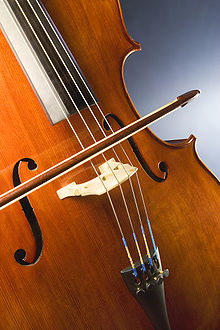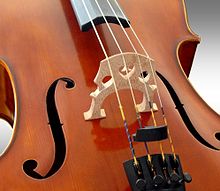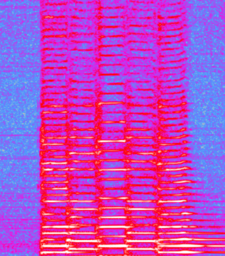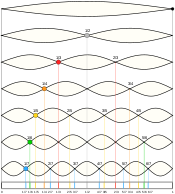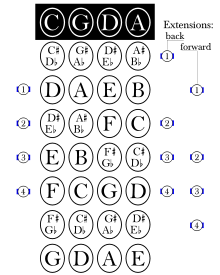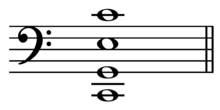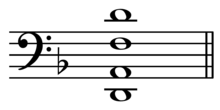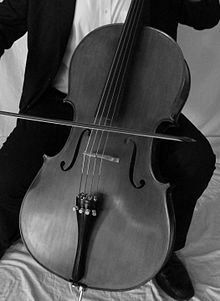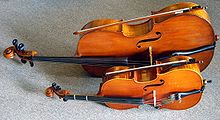- Cello
-
Cello 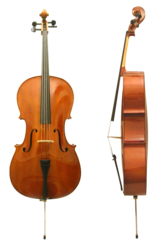
Cello, front and side viewString Other names Violoncello Hornbostel–Sachs classification 321.322-71
(Composite chordophone sounded by a bow)Developed about 1660 from the bass violin Playing range Related instruments - Violin family (violin, viola)
- Viol family (includes double bass)
Musicians - List of Cellists
The cello (pronounced /ˈtʃɛloʊ/ chel-oh; plural cellos or celli) is a bowed string instrument with four strings tuned in perfect fifths. It is a member of the violin family of musical instruments, which also includes the violin, viola, and double bass. Old forms of the instrument in the Baroque era are baryton and viol (viola da gamba).
A person who plays a cello is called a cellist. The cello is used as a solo instrument, in chamber music, in a string orchestra and as a member of the string section of an orchestra. It is the second largest bowed string instrument in the modern symphony orchestra, the double bass being the largest.
Cellos were derived from other mid- to large-sized bowed instruments in the 16th century, such as the viola da gamba, and the generally smaller and squarer viola da braccio, and such instruments made by members of the Amati family of luthiers. The invention of wire-wrapped strings in Bologna gave the cello greater versatility. By the 18th century the cello had largely replaced other mid-sized bowed instruments.
Contents
Etymology
The name cello is an abbreviation of the Italian violoncello, which means "little violone", referring to the violone ("big viol"), the lowest-pitched instrument of the viol family, the group of string instruments that went out of fashion around the end of the 17th century in most countries except France, where they survived another half-century or so before the louder violin family came into greater favour in that country too. Thus, the name carries both an augmentative "-one" ("big") and a diminutive "-cello" ("little"). By the turn of the 20th century, it had grown customary to abbreviate the name violoncello to 'cello, with the apostrophe indicating the six missing prefix letters.[1] It is now customary to use the name "cello" without the apostrophe and as a full designation.[1] The word derives ultimately from vitula, meaning a stringed instrument.
Description
Cellos are tuned in fifths, starting with C2 (two octaves below middle C) as the lowest string, followed by G2, D3, and A3. It is tuned in same intervals as the viola, but an octave lower. Unlike the violin or viola but similar to the double bass, the cello has a endpin resting on the floor in order to support its heavy weight. The cellist Paul Tortelier is credited with inventing a bent pin, enabling the instrument to lie more horizontally than vertically.[2]
The cello is most closely associated with European classical music, and has been described as the closest sounding instrument to the male human voice.[3] The instrument is a part of the standard orchestra and is the bass voice of the string quartet, as well as being part of many other chamber groups. A large number of concertos and sonatas have been written for the cello.
Among the most well-known Baroque works for the cello are Johann Sebastian Bach's six unaccompanied Suites. The Prelude from the First Suite is particularly famous. From the Classical era, the two concertos by Joseph Haydn in C major and D major stand out, as do the five sonatas for cello and pianoforte of Ludwig van Beethoven, which span the important three periods of his compositional evolution. Romantic era repertoire includes the Robert Schumann Concerto, the Antonín Dvořák Concerto as well as the two sonatas and the Double Concerto by Johannes Brahms. Compositions from the early 20th century include Edward Elgar's Cello Concerto in E minor, Claude Debussy's Sonata for Cello and Piano and unaccompanied cello sonatas by Zoltán Kodály and Paul Hindemith. The cello's versatility made it popular with composers in the mid- to late 20th century such as Sergei Prokofiev, Dmitri Shostakovich, Benjamin Britten, György Ligeti and Henri Dutilleux, encouraged by soloists who specialized in contemporary music (such as Siegfried Palm and Mstislav Rostropovich) commissioning from and collaborating with composers.
Today the instrument is less common in popular music, but was commonly used in 1970's pop and disco music.[citation needed] Today it is still sometimes featured in pop and rock recordings, examples of which are noted later in this article. The cello has also recently appeared in major hip-hop and R & B performances, such as singers Rihanna and Ne-Yo's performance at the American Music Awards.[citation needed] The instrument has also been modified for Indian classical music by Nancy Lesh and Saskia Rao-de Haas.[4]
History
The history of bowed string musical instruments in Europe dates back to the 9th century with the lira (Greek: λύρα, Latin: lūrā), the bowed instrument of the Byzantine Empire, equivalent to the rabāb of the Islamic Empires. The Persian geographer Ibn Khurradadhbih (d. 911) of the 9th century, in his lexicographical discussion of instruments, cited the Byzantine lira as a typical instrument of the Byzantines along with the urghun (organ), shilyani (probably a type of harp or lyre) and the salandj.[5] The Byzantine lira spread through Europe westward and in the 11th and 12th centuries European writers use the terms fiddle and lira interchangeably when referring to bowed instruments (Encyclopædia Britannica. 2009). In the meantime the Arab rabāb was introduced to the Western Europe possibly through the Iberian Peninsula and both bowed instruments spread widely throughout Europe giving birth to various European bowed instruments.
Over the centuries that followed, Europe continued to have two distinct types of bowed instruments: one, relatively square-shaped, held in the arms, known with the Italian term Lira da braccio (or Viola da braccio, meaning viol for the arm), family of the modern violin; the other, with sloping shoulders and held between the knees, known with the Italian term Lira da gamba (or viola da gamba, meaning viol for the leg), family of the Byzantine lyra and the modern Cello.[6] During the Renaissance, the gambas were important and elegant instruments; they eventually lost ground to the louder (and originally less aristocratic) lira da braccio. However, the a gamba playing position remained popular to larger instruments that could not be played with a braccio position.
The violoncello da spalla (sometimes "violoncello piccolo da spalla" or "violoncello da span") was the first cello referred to in print (by Jambe de Fer in 1556).[1] "Violone" means a larger "viola" (viol), while "-cello" in Italian is a diminutive and spalla means "shoulder" in Italian so that violoncello da spalla suggest a "little big violin" that may be held on the shoulder so that the player could perform while walking or that the early, short-necked instrument was hung across the shoulder by a strap.[1]
Monteverdi referred to the instrument as "basso de viola da braccio" in Orfeo (1607). Although the first bass violin, possibly invented as early as 1538, was most likely inspired by the viol, it was created to be used in consorts with the violin. The bass violin was actually often referred to as a "violone," or "large viola," as were the viols of the same period. Instruments that share features with both the bass violin and the viola de gamba appear in Italian art of the early 16th century.
The invention of wire-wound strings (fine wire around a thin gut core), around 1660 in Bologna, allowed for a finer bass sound than was possible with purely gut strings on such a short body. Bolognese makers exploited this new technology to create the cello, a somewhat smaller instrument suitable for solo repertoire due to both the timbre of the instrument and the fact that the smaller size made it easier to play virtuosic passages. This instrument had disadvantages as well, however. The cello's light sound was not as suitable for church and ensemble playing, so it had to be doubled by basses or violones.
Around 1700, Italian players popularized the cello in northern Europe, although the bass violin (basse de violon) continued to be used for another two decades in France.[citation needed] Many existing bass violins were literally cut down in size to convert them into cellos according to the smaller pattern developed by Stradivarius, who also made a number of old pattern large cellos (the 'Servais').[7] The bass violin remained the "most used" instrument in England as late as 1740, where the violoncello was still "not common."[8] The sizes, names, and tunings of the cello varied widely by geography and time.[7] The size was not standardized until around 1750.
Despite similarities to the viola da gamba, the cello is actually part of the viola da braccio family, meaning "viol of the arm," which includes, among others, the violin and viola. Though paintings like Bruegel's "The Rustic Wedding" and de Fer in his Epitome Musical suggest that the bass violin had alternate playing positions, these were short-lived and the more practical and ergonomic a gamba position eventually replaced them entirely.
Baroque era cellos differed from the modern instrument in several ways. The neck has a different form and angle, which matches the baroque bass-bar and stringing. Modern cellos have an endpin at the bottom to support the instrument (and transmit some of the sound through the floor), while Baroque cellos are held only by the calves of the player. Modern bows curve in and are held at the frog; Baroque bows curve out and are held closer to the bow's point of balance. Modern strings normally have a metal core, although some use a synthetic core; Baroque strings are made of gut, with the G and C strings wire-wound. Modern cellos often have fine-tuners connecting the strings to the tailpiece, which make it much easier to tune the instrument, but such pins are rendered ineffective by the flexibility of the gut strings used on Baroque cellos. Overall, the modern instrument has much higher string tension than the Baroque cello, resulting in a louder, more projecting tone, with fewer overtones.
No educational works specifically devoted to the cello existed before the 18th century, and those that do exist contain little value to the performer beyond simple accounts of instrumental technique. The earliest cello manual is Michel Corrette's Méthode, thèorique et pratique pour apprendre en peu de temps le violoncelle dans sa perfection (Paris, 1741).
Current use
Orchestral
Cellos are part of the standard symphony orchestra, which usually includes eight to twelve players. The cello section, in standard orchestral seating, is located on stage left (the audience's right) in the front, opposite the first violin section. However, some orchestras and conductors prefer switching the positioning of the viola and cello sections. The principal cellist is the section leader, determining bowings for the section in conjunction with other string principals, and playing solos. Principal players always sit closest to the audience.
The cellos are a critical part of orchestral music; all symphonic works involve the cello section, and many pieces require cello soli or solos. Much of the time, cellos provide part of the harmony for the orchestra. On many occasions, the cello section will play the melody for a brief period of time, before returning to the harmony. There are also cello concertos, which are orchestral pieces in which a featured, solo cellist is accompanied by an entire orchestra.
Solo
There are numerous cello concertos - where a solo cello is accompanied by an orchestra - notably 25 by Vivaldi, 12 by Boccherini, 2 by Haydn, 3 by C.P.E. Bach, 2 by Saint-Saëns, 1 by Dvořák, and one each by Schumann, Lalo, and Elgar. Beethoven's Triple Concerto for Cello, Violin and Piano and Brahms' Double Concerto for Cello and Violin are also part of the concertante repertoire although in both cases the cello shares solo duties with at least one other instrument. Moreover, several composers wrote large-scale pieces for cello and orchestra, which are concertos in all but name. Some familiar "concertos" are Strauss' tone poem Don Quixote, Tchaikovsky's Variations on a Rococo Theme, Bloch's Schelomo and Bruch's Kol Nidrei.
In the 20th century, the cello repertoire grew immensely. This was partly due to the influence of virtuoso cellist Mstislav Rostropovich who inspired, commissioned and/or premiered dozens of new works. Among these, Prokofiev's Symphonia Concertante, Britten's Cello Symphony and the concertos of Shostakovich, Lutosławski and Dutilleux have already become part of the standard repertoire. Other major composers who wrote concertante works for him include Messiaen, Berio and Penderecki. In addition, Arnold, Barber, Glass, Hindemith, Honegger, Ligeti, Myaskovsky, Penderecki, Rodrigo, Villa-Lobos and Walton also wrote major concertos for other cellists, notably for Gaspar Cassadó, Gregor Piatigorsky, Siegfried Palm and Julian Lloyd Webber.
There are also many sonatas for cello and piano. Those written by Beethoven, Mendelssohn, Chopin, Brahms, Grieg, Rachmaninoff, Debussy, Fauré, Shostakovich, Prokofiev, Poulenc, Carter, and Britten are the most famous. Other important pieces for cello and piano include Schumann's five Stücke im Volkston and transcriptions like Schubert's sonata in a minor (originally for arpeggione and piano), Stravinsky's Suite Italienne (transcribed by the composer from his ballet Pulcinella) and Bartók's first rhapsody (also transcribed by the composer, originally for violin and piano)
Finally, there are several pieces for cello solo, most importantly J.S. Bach's six Suites for Cello (arguably the most important cello pieces), Kodály's Sonata for Solo Cello and Britten's three Cello Suites. Other notable examples include Hindemith's and Ysaÿe's Sonatas for Solo Cello, Dutilleux' Trois Strophes sur le Nom de Sacher, Berio's Les Mots Sont Allés (both part of a series of twelve compositions for solo cello commissioned by Rostropovich for Swiss conductor Paul Sacher's 70th birthday), Cassado's "Suite for Solo Cello", Ligeti's Sonata, Carter's two Figments and Xenakis' Nomos Alpha and Kottos.
Quartets and other ensembles
The cello is a member of the traditional string quartet as well as string quintets, sextet or trios and other mixed ensembles. There are also pieces written for two, three, four or more cellos; this type of ensemble is also called a "cello choir" and its sound is familiar from the introduction to Rossini's William Tell Overture as well as Zaccharias' prayer scene in Verdi's Nabucco. As a self-sufficient ensemble, its most famous repertoire is Villa-Lobos' first of his Bachianas Brasileiras for cello ensemble (the fifth is for soprano and 8 cellos). Other examples are Offenbach's cello duets, quartet, and sextet, Pärt's Fratres for 8 cellos and Boulez' Messagesquisse for 7 cellos, or even Villa-Lobos' rarely played Fantasia Concertante (1958) for 32 cellos. The Twelve Cellists of the Berlin Philharmonic Orchestra (or "the Twelve" as they have since taken to being called) specialize in this repertoire and have commissioned many works, including arrangements of well-known popular songs.
Popular music, jazz and neoclassical
Though the cello is less common in popular music than in classical music, it is sometimes featured in pop and rock recordings. The cello is rarely part of a group's standard lineup but like its cousin the violin it is becoming more common in mainstream pop (e.g. the baroque rock band Arcade Fire uses the cello in their songs).
In the 1960s, artists such as the Beatles and Cher used the cello in popular music, in songs such as "Bang Bang (My Baby Shot Me Down)", "Eleanor Rigby" and "Strawberry Fields Forever". Bass guitarist Jack Bruce, who had originally studied music on a performance scholarship for cello, played a prominent cello part in "As You Said" on Cream's Wheels of Fire studio album (1968). In the 1970s, the Electric Light Orchestra enjoyed great commercial success taking inspiration from so-called "Beatlesque" arrangements, adding the cello (and violin) to the standard rock combo line-up and in 1978 the UK based rock band, Colosseum II, collaborated with cellist Julian Lloyd Webber on the recording Variations. Most notably, Pink Floyd included a cello solo in their 1970 epic instrumental "Atom Heart Mother". Bass guitarist Mike Rutherford of Genesis was originally a cellist and included some cello parts in their Foxtrot album.
Established non-traditional cello groups include Apocalyptica, a group of Finnish cellists best known for their versions of Metallica songs, Rasputina, a group of cellists committed to an intricate cello style intermingled with Gothic music, Von Cello, a cello fronted rock power trio, Break of Reality who mix elements of classical music with the more modern rock and metal genre, and Jelloslave ([1]) a Minneapolis based Cello duo with two percussionists. These groups are examples of a style that has become known as cello rock. The crossover string quartet bond also includes a cellist. Silenzium and Vivacello are Russian (Novosibirsk) groups playing rock and metal and having more and more popularity in Siberia. Cold Fairyland from Shanghai, China is using a cello along a Pipa as the main solo instrument to create East meets West progressive (folk) rock.
More recent bands using the cello are Aerosmith, The Auteurs, Nirvana, Oasis, Murder by Death, Cursive, A Genuine Freakshow, Ra Ra Riot, Smashing Pumpkins, James, and OneRepublic. An Atlanta-based trio, King Richard's Sunday Best, also uses a cellist in their lineup. So-called "chamber pop" artists like Kronos Quartet, The Vitamin String Quartet and Margot and the Nuclear So and So's have also recently made cello common in modern alternative rock. Heavy metal band System of a Down has also made use of the cello's rich sound. The indie rock band The Stiletto Formal are known for using a cello as a major staple of their sound, similarly, the indie rock band Canada employs two cello players in their lineup. The orch-rock group, The Polyphonic Spree, which has pioneered the use of stringed and symphonic instruments, employs the cello in very creative ways for many of their "psychedelic-esque" melodies. The first wave screamo band I Would Set Myself On Fire For You featured a cello as well as a viola to create a more folk-oriented sound. The band, Panic! At the Disco uses a cello in their song, "Build God, Then We'll Talk." The lead vocalist of the band, Brendon Urie, also did the recording of the cello solo.
In jazz, bassists Oscar Pettiford and Harry Babasin were among the first to use the cello as a solo instrument; both tuned their instrument in fourths, an octave above the double bass. Fred Katz (who was not a bassist) was one of the first notable jazz cellists to use the instrument's standard tuning and arco technique. Contemporary jazz cellists include Abdul Wadud, Diedre Murray, Ron Carter, Dave Holland, David Darling, Lucio Amanti, Akua Dixon, Ernst Reijseger, Fred Lonberg-Holm, Tom Cora, Vincent Courtois, Jean-Charles Capon, Erik Friedlander, and James Hinkley of jazz combo Billet-Deux.
Modern musical theatre pieces like Jason Robert Brown's The Last Five Years, Duncan Sheik's Spring Awakening, Adam Guettel's Floyd Collins, and Ricky Ian Gordon's My Life with Albertine use small string ensembles (including solo cellos) to a prominent extent.
The cello can also be used in bluegrass and folk music, with notable players including Ben Sollee of the Sparrow Quartet and the "Cajun cellist" Sean Grissom as well as Damien Rice. Lindsay Mac is becoming well known for playing the cello like a guitar, with her cover of The Beatles' "Blackbird" a big hit on The Bob & Tom Show.
Construction
The cello is typically made from wood, although other materials such as carbon fibre or aluminum may be used. A traditional cello has a spruce top, with maple for the back, sides, and neck. Other woods, such as poplar or willow, are sometimes used for the back and sides. Less expensive cellos frequently have tops and backs made of laminated wood.
The top and back are traditionally hand-carved, though less expensive cellos are often machine-produced. The sides, or ribs, are made by heating the wood and bending it around forms. The cello body has a wide top bout, narrow middle formed by two C-bouts, and wide bottom bout, with the bridge and F holes just below the middle.
The top and back of the cello has decorative border inlay known as purfling. While purfling is attractive, it is also functional: if the instrument is struck, the purfling can prevent cracking of the wood. A crack may form at the rim of the instrument, but will spread no further. Without purfling, cracks can spread up or down the top or back. Playing, traveling and the weather all affect the cello and can increase a crack if purfling is not in place. Less expensive instruments typically have painted purfling.
Alternative materials
Cello manufacturer Luis & Clark constructs cellos from carbon fibre. Carbon fibre instruments are particularly suitable for outdoor playing because of the strength of the material and its resistance to humidity and temperature fluctuations. Luis & Clark has produced over 600 such cellos, some of which are owned by cellists such as Yo-Yo Ma[9] and Josephine van Lier.[10]
In the late 1920s and early 1930s, the Aluminum Company of America (Alcoa) as well as German luthier G.A. Pfretzschner produced an unknown number of aluminum cellos (in addition to aluminum double basses and violins). An advertisement published in N.Y. Music Service catalogue (1930) reads: "...made entirely of aluminum with the exception of the fingerboard. They have many advantages over the wood basses and violoncellos, as they cannot crack, split or warp and are made to last forever ... possessing a tone quality that is deep, resonant and responsive to the utmost degree. Violoncello $150." Only a handful of aluminum cellos exist today including a Pfretzschner played by modern classical cellist Frances-Marie Uitti, another played by bluegrass cellist Stan Young.
Neck, pegbox, and scroll
Above the main body is the carved neck, which leads to a pegbox and the scroll. The neck, pegbox, and scroll are normally carved out of a single piece of wood. Attached to the neck and extending over the body of the instrument is the fingerboard. The nut is a raised piece of wood, where the fingerboard meets the pegbox, which the strings rest on. The pegbox houses four tuning pegs, one for each string. The pegs are used to tune the cello by either tightening or loosening the string. The scroll is a traditional part of the cello and all other members of the violin family. Ebony is usually used for the tuning pegs, fingerboard, and nut, but other hard woods, such as boxwood or rosewood, can be used.
Strings
Strings on a cello have cores made out of gut (sheep or goat), metal, or synthetic materials, such as Perlon. Most modern strings used today are also wound with metallic materials like aluminum, titanium and chromium. Cellists may mix different types of strings on their instruments. The pitches of the open strings are C, G, D, and A (black note heads in the playing range figure above), unless alternative tuning (scordatura) is used.
Tailpiece and endpin
The tailpiece and endpin are found in the lower part of the cello. The tailpiece is traditionally made of ebony or another hard wood, but can also be made of plastic or steel. It attaches the strings to the lower end of the cello, and can have one or more fine tuners. The endpin or spike is made of wood, metal or rigid carbon fibre and supports the cello in playing position. In the Baroque period the cello was held between the calves. Around the 1830s, the Belgian cellist Auguste Adrien Servais introduced the endpin and propagated its use. Modern endpins are retractable and adjustable; older ones were removed when not in use. (The word "endpin" sometimes also refers to the button of wood located at this place in all instruments in the violin family, but this is usually called "tailpin".[11]) The sharp tip of the cello's endpin is sometimes capped with a rubber tip that protects the tip from dulling and prevents the cello from slipping on the floor.
Bridge and f-holes
The bridge holds the strings above the cello and transfers their vibrations to the top of the instrument and the soundpost inside (see below). The bridge is not glued, but rather held in place by the tension of the strings. The f-holes, named for their shape, are located on either side of the bridge, and allow air to move in and out of the instrument as part of the sound-production process. The f-holes also act as access points to the interior of the cello for repairs or maintenance. Sometimes a small hose containing a water-soaked sponge, called a Dampit, is inserted through the f-holes, and serves as a humidifier.
Internal features
Internally, the cello has two important features: a bass bar, which is glued to the underside of the top of the instrument, and a round wooden sound post, which is wedged between the top and bottom plates. The bass bar, found under the bass foot of the bridge, serves to support the cello's top and distribute the vibrations. The sound post, found under the treble side of the bridge, connects the back and front of the cello. Like the bridge, the sound post is not glued, but is kept in place by the tensions of the bridge and strings. Together, the bass bar and sound post transfer the strings' vibrations to the top (front) of the instrument (and to a lesser extent the back), acting as a diaphragm to produce the instrument's sound.
Glue
Cellos are constructed and repaired using hide glue, which is strong but reversible, allowing for disassembly when needed. Tops may be glued on with diluted glue, since some repairs call for the removal of the top. Theoretically, hide glue is weaker than the body's wood, so as the top or back shrinks side-to-side, the glue holding it will let go, avoiding a crack in the plate.
Bow
Traditionally, bows are made from pernambuco or brazilwood. Both come from the same species of tree (Caesalpina echinata), but pernambuco, used for higher-quality bows, is the heartwood of the tree and is darker in color than brazilwood (which is sometimes stained to compensate). Pernambuco is a heavy, resinous wood with great elasticity, which makes it an ideal wood for instrument bows.
Bows are also made from other materials, such as carbon-fibre—stronger than wood—and fiberglass (often used to make inexpensive, low-quality student bows). An average cello bow is 73 cm long (shorter than a violin or viola bow) 3 cm high (from the frog to the stick) and 1.5 cm wide. The frog of a cello bow typically has a rounded corner like that of a viola bow, but is wider. A cello bow is roughly 10 grams heavier than a viola bow, which in turn is roughly 10 grams heavier than a violin bow.
Bow hair is traditionally horsehair, though synthetic hair, in varying colors, is also used. Prior to playing, the musician tightens the bow by turning a screw to pull the frog (the part of the bow under the hand) back, and increase the tension of the hair. Rosin is applied by the player to make the hairs sticky. Bows need to be re-haired periodically.
Baroque style (1600–1750) cello bows were much thicker and were formed with a larger outward arch when compared to modern cello bows. The inward arch of a modern cello bow produces greater tension, which in turn gives off a louder sound.
The cello bow, though not made conventionally for the use, has also been used to play guitars. The post-rock Icelandic band Sigur Rós' lead singer often plays a guitar using a cello bow, as did Jimmy Page on tracks such as "Dazed and Confused".
Physics
Physical aspects
When a string is bowed or plucked, it vibrates, or moves the air around it, producing sound waves. Because the string is quite thin, not as much air is moved, and consequently the sound is weak. In acoustic stringed instruments such as the cello, this lack of volume is solved by mounting the vibrating string on a larger body. The vibrations are transmitted to the larger body, which can move more air and produce a louder sound. The design of the instrument produces variations in the instrument’s vibrational patterns and thus changes the character of the sound produced.[12]
A string’s fundamental pitch can be adjusted by changing its stiffness, which depends on tension and length. Tightening a string stiffens it by increasing both the outward forces along its length and the net forces it experiences during a distortion.[13] A cello can be tuned by adjusting the tension in its strings using pegs in its neck and tension adjusters (fine tuners) on the tail piece.
A string’s length also affects its fundamental pitch. Shortening a string stiffens it by increasing its curvature during a distortion and subjecting it to larger net forces. Shortening the string also reduces its mass. Since a stiffer string with a smaller mass vibrates faster, shortening a string increases the pitch. Because of this effect, you can raise and change the pitch of a string by pressing it against the fingerboard in the cello’s neck and effectively shortening it.[13]
Subjective aspects
When a string is bowed or plucked to produce a note, the fundamental note is accompanied by other higher, overtone frequencies. Each sound has a particular recipe of frequencies that combine to make the total sound.[14]
For the cello, the main wood resonance generally appears very close to the note F#2, often with serious consequences. When the cellist plays the note F#2, the main wood resonance vibrates at its frequency as the cello sounds the frequency of the note F#2. A loud beating sound results between these nearby frequencies; this is known as the “wolf tone” because it is an unpleasant growling sound. The wood resonance appears to be split into two frequencies by the driving force of the sounding string. These two periodic resonances beat with each other. This wolf tone must be eliminated or significantly reduced for the cello to play the nearby notes with a pleasant tone. This can be accomplished by modifying the cello front plate, attaching a wolf eliminator, or moving the sound post.[15]
Harmonics
A vibrating string subdivides itself into many parts vibrating at the same time. Each part produces a pitch of its own, called a partial. A vibrating string has one fundamental and a series of partials. The most pure combination of two pitches is when one is double the frequency of the other.[15]
For a repeating wave, the velocity, v, equals the wavelength, λ, times the frequency, f. v = λf On a cello string, waves reflect from both ends. The superposition of reflecting waves results in a standing wave pattern, but only for wavelengths λ = 2L, L, L/2, … = 2L/n, where L is the length of the string. Therefore the only frequencies produced on a single string are f = nv/(2L). Timbre is largely determined by the content of these harmonics. Different instruments have different harmonic content for the same pitch. A real string vibrates at harmonics that are not perfect multiples of the fundamental. This results in a little in-harmonicity, which gives richness to the tone and covers up slight de-tunings of different notes in a chord.[16]
Playing technique
Body position
The cello is played while seated. Its weight is supported mainly by its endpin or spike, which rests on the floor.[17] The cello is steadied on the lower bout between the knees of the seated player, and on the upper bout against the upper chest. The neck of the cello is above the player's left shoulder, and the C-String tuning peg is just behind the left ear. The bow is drawn horizontally across the strings. In early times, female cellists sometimes played side-saddle, since it was considered improper for a lady to part her knees in public. A player's handedness does not alter the way the cello is held or used. In rare cases, a player has used a mirror-image posture—usually because of a physical disability of the arm or hand that makes the required technique impossible for that side of the body. In such a situation, the player must decide whether or not to reverse the set-up of the cello (the string positions, bass-bar, sound post, fingerboard shape, and bridge carving are all asymmetrical).
Left hand technique
The left hand fingertips stop the strings along their length, determining the pitch of each fingered note. Stopping the string closer to the bridge results in higher-pitched sound, because the vibrating string length has been shortened. In the neck positions (which use just less than half of the fingerboard, nearest the top of the instrument), the thumb rests on the back of the neck; in thumb position (a general name for notes on the remainder of the fingerboard) the thumb usually rests alongside the fingers on the string and the side of the thumb is used to play notes. The fingers are normally held curved with each knuckle bent, with the fingertips in contact with the string. If a finger is required on two (or more) strings at once to play perfect fifths (in double stops or chords) it is used flat. In slower, or more expressive playing, the contact point can move slightly away from the nail to the pad of the finger, allowing a fuller vibrato.
Vibrato
Vibrato is a small oscillation in the pitch of a note, usually considered expressive. It is not created by an upper arm motion; rather, it is more of forearm motion. The fixed point of contact of the fingertip on the string absorbs this motion by rocking back and forth. This change in the attitude of the fingertip to the string varies the pitch. Since vibrato is usually considered a key expressive device, a well-developed vibrato technique is an essential element of a modern cellist's skill. In some styles of music, such as that of the Romantic period, vibrato may be used on almost every note. However, in other styles, such as Baroque repertoire, vibrato is used only rarely, as an ornament. In any case, the choice of whether to use vibrato, and how much, is normally a stylistic decision on the part of the player. Typically, the lower the pitch of the note played, the wider and slower the vibrato.
Harmonics
Harmonics played on the cello fall into two classes; natural and artificial. Natural harmonics are produced by lightly touching (but not depressing) the string with the finger at certain places, and then bowing (or, rarely, plucking) the string. For example, the halfway point of the string will produce a harmonic that is one octave above the unfingered (open) string. Natural harmonics only produce notes that are part of the harmonic series on a particular string. Artificial harmonics (also called false harmonics or stopped harmonics), in which the player depresses the string fully with one finger while touching the same string lightly with another finger, can produce any note above middle C. They usually appear with the touching note a perfect fourth above the stopped note, which produces a sound two octaves above the stopped note, although other intervals are available. All harmonics produce a distinctive flute-like sound, and are usually performed without vibrato.
Glissando
Glissando (Italian for "sliding") is an effect played by sliding the finger up or down the fingerboard without releasing the string. This causes the pitch to rise and fall smoothly, without separate, discernible steps.
Right hand technique
In cello playing, the bow is much like the breath of a wind instrument player. Arguably, it is the major determinant in the expressiveness of the playing. The right hand holds the bow and controls the duration and character of the notes. The bow is drawn across the strings roughly halfway between the end of the fingerboard and the bridge, in a direction perpendicular to the strings. The bow is held with all five fingers of the right hand, the thumb opposite the fingers and closer to the cellist's body. The shape of the hand should resemble that of its relaxed state, with all fingers curved, including the thumb. The transmission of weight from the arm to the bow happens through the pronation (inward rotation) of the forearm, which pushes the index finger and to a lesser degree the middle finger onto the bow. The necessary counterforce is provided by the thumb. Depending upon the school of training, the other two fingers are used in various degrees to help maintain the angle of the bow to the string and are critical to controlling the bow when it is off the string. (See also spiccato).
In English, the terminology for bow direction (up and down) can be misleading. A downbow is drawn to the right of the player, and an upbow to the left. A downbow is drawn by first using the upper arm, then the forearm, then the wrist (turning slightly inward) to maintain a straight stroke. An upbow is drawn by moving first the forearm, then the upper arm, then the wrist (pushing slightly upward). The bow is mostly used perpendicular to the strings. To perform string changes the whole arm is either lowered or lifted, with as little wrist movement as possible to maintain the angle to the string. However, flexibility of the wrist is necessary when changing the bow direction from up-bow to down-bow and vice versa. For very fast bow movements, the wrist is used to accomplish the horizontal movement of the bow. For longer strokes, the arm is used as well as the wrist.
Tone production and volume of sound depend on a combination of several factors. The three most important ones are: bow speed, weight applied to the string, and point of contact of the bow hair with the string. A good player will be capable of a very even tone, and will counter the natural tendency to play with the most force with the part of the bow nearest to the frog or heel, and the least force near the tip. The closer to the bridge the string is bowed, the more projecting and brighter the tone, with the extreme (sul ponticello) producing a metallic, shimmery sound. If bowing closer to the fingerboard (sul tasto), the sound produced will be softer, more mellow, and less defined.
Double stops
Double stops involve the playing of two notes at the same time. Two strings are fingered simultaneously, and the bow is drawn so as to sound them both at once. Triple and quadruple stops may also be played (in a "broken" fashion), but are difficult to sustain because of the change in slope of the bridge. To extend the technique in this area, Frances-Marie Uitti has invented a two-bow system: one bow plays above the strings and one below, allowing for sustained triple and quadruple stops. However, this technique is very rarely seen or used.
Pizzicato
In pizzicato playing, the string is plucked directly with the fingers or thumb. Position of the hand is slightly over the finger board and away from the bridge. Usually this is done with the right hand, while the bow is held away from the strings by the rest of the hand or (for extended passages) set down. A single string can be played pizzicato, or double, triple, or quadruple stops can be played. Occasionally, a player must bow one string with the right hand and simultaneously pluck another with the left. This is marked by a "+" above the note. Strumming of chords is also possible, in guitar fashion.
Col legno
A player using the Col legno technique rubs the strings with the wood of the bow rather than the hair. There are two forms, col legno battuto and col legno tratto. Col legno battuto is performed as a percussive technique with no sustaining of the sound. The much less common alternative is col legno tratto, wherein the wood is drawn across the string as the hair is in a normal bow stroke. Some players refuse to use this technique because of potential damage to the bow.
Spiccato
In spiccato playing, the strings are not "drawn" by the bow hair but struck by it, while still retaining some horizontal motion, to generate a more percussive, crisp sound. It may be performed by using the wrist to "dip" the bow into the strings. Spiccato is usually associated with lively playing. On a violin, spiccato bowing comes off the string, but on a cello, the wood of the bow may rise briskly up without the hair actually leaving the string. While playing spiccato, the bow is literally bouncing off the string. Cello players simply "dip" the bow into the string, and touch it very fast, and then lift the bow off the string.
Staccato
In staccato, the player moves the bow a small distance and stops it on the string, making a short sound, the rest of the written duration being taken up by silence.
Legato
Legato is a technique where the notes are smoothly connected without accents or breaks.
Sul ponticello/sul tasto
Sul ponticello ("on the bridge") refers to bowing closer to the bridge, while sul tasto ("on the fingerboard") calls for bowing nearer the end of the fingerboard. (While reading music, "tasto" can also mean to play with the bow in normal postiton when having been playing "ponticello") Ponticello calls for more bow weight and slower bow speed, and produces a "harder" sound, with strong overtone content. Sul tasto, in extreme cases called "flautando," produces a more flute-like sound, with more emphasis on the fundamental frequency of the note, and softer overtones.
Con/Senza sord.
This refers to using a mute, or sordino, which is placed on the bridge to mellow or soften the tone, or to take it off.
Sizes
Standard-sized cellos are referred to as "full-size". However, cellos come in smaller (fractional) sizes, from "7/8" and "3/4" down to "1/16" sized cellos (e.g. 7/8, 3/4, 1/2, 1/4, 1/8, 1/10, 1/16). The smaller-sized cellos are identical to standard cellos in construction, range, and usage, but are simply 'scaled-down' for the benefit of children and shorter adults. Note that a "half-size" cello is half the volume of a full-size, not half the length (i.e., the 1/8-size cello would be "half-size" in terms of length).[citation needed] A 1/10-size cello, for example, which is meant to be used by small children, is only slightly larger than a violin (and as such can be played by an adult player like one), but about twice as thick, and the C string tends to be quite slack due to the difficulty for such a small string to produce a sound that low. Many smaller cellists prefer to play a "7/8" cello as the hand stretches in the lower positions are less demanding. Although rare, cellos in sizes larger than 4/4 do exist. Cellists with unusually large hands may play a slightly larger than full-sized cello. Cellos made before approximately 1700 tended to be considerably larger than those made and commonly played today.
Around 1680, string-making technology made lower pitches on shorter strings possible. The cellos of Stradivari, for example, can be clearly divided into two models, the style made before 1702 characterized by larger instruments (of which only three exist in their original size and configuration), and the style made during and after 1702, when Stradivari, presumably in response to the "new" strings, began making smaller cellos. This later model is the one most commonly used by modern luthiers.
Approximate dimensions for 4/4 size cello[18] Average size (cm) Average size (in) Approximate width horizontally from A peg to C peg ends 16 6 - 5/16 Back length excluding half round where neck joins 75.5 29 - 3/4 Upper bouts (shoulders) 34 13 - 3/8 Lower bouts (hips) 44 17 - 3/8 Bridge height 9 3 - 9/16 Rib depth at shoulders including edges of front and back 12.5 4 - 15/16 Rib depth at hips including edges 12.8 5 - 1/16 Distance beneath fingerboard to surface of belly at neck join 2.2 7/8 Bridge to back total depth 26.7 10 - 1/2 Overall height excluding end pin 121 47 - 10/16 End pin unit and spike 5.5 2 - 5/8 Accessories
There are many accessories for the cello.
- Cases are used to protect the cello and bow (or multiple bows) when traveling and for safe storage. They are often made of carbon fiber, fiber-glass, and less commonly wood.
- Rosin, made from conifer resin, is applied to the bow hairs to increase the effectiveness of the friction, grip or bite, and allow proper sound production. Rosin may have additives to modify the friction such as beeswax, gold, silver or tin. Commonly, rosins are classified as either Dark or Light. Dark rosins increase the friction more than Light rosins.
- Endpin stops or straps (tradenames include Rockstop and Black Hole) keep the cello from sliding if the end pin does not have a rubber piece on the end (used on wood floors) though in many cases a rubber piece will not suffice on even a wood floor. Many Cellists often use a square or rectangle of carpet that can be secured under the front two legs of the chair as an endpin stop. This is however less likely to be seen in a professional arena and more used in rehearsal or in private.
- Wolf tone eliminators are often placed on cello strings between the tailpiece and the bridge to eliminate acoustic anomalies known as wolf tones or "wolfs".
- Mutes are used to change the sound of the cello by reducing overtones. Practice mutes (made of metal) significantly reduce the instrument's volume (they are also referred to as "hotel mutes"). The most common mute is a rubber disc with two holes to fit the two middle strings. It sits just after the bridge and has a flap that can be placed over the top of the bridge to mute the vibrations travelling down it to the sound post inside the cello. These are especially used due to their simplicity and can be taken off or put on very quickly because they can be stored on the strings past the bridge.
- Metronomes provide a steady tempo by sounding out a certain number of beats per minute. They are adjustable to fit the tempo of the piece. Many models can also produce a tuning pitch of A4 (440 Hz), among others. These can, of course, be used for all instruments.
- Humidifiers are used to control and stabilize the humidity around and inside the cello and are popular with traveling cellists. Often, these are placed inside the cello itself or inside the case. Some players will not use humidifiers inside their cellos because they have the potential to drip, which may cause damage to the cello.
- Electronic tuners are sometimes used to tune the instrument. A tuner indicates if a played note is sharp or flat.
Instrument makers
Cellos are made by luthiers, specialists in building and repairing stringed instruments, ranging from guitars to violins. The following luthiers are notable for the cellos they have produced:
- Nicolò Amati and others in the Amati family
- William Forster
- Nicolò Gagliano
- Matteo Goffriller
- Giovanni Battista Guadagnini
- Giuseppe Guarneri
- Domenico Montagnana
- Giovanni Battista Rogeri
- Francesco Ruggieri
- Stefano Scarampella
- Antonio Stradivari
- David Tecchler
- Carlo Giuseppe Testore
- Jean Baptiste Vuillaume
Cellists
A person who plays the cello is called a cellist. For a list of notable cellists, see the list of cellists and Category:Cellists.
Famous cellos
See also: Category:Individual cellosSpecific instruments are, or become, famous, for a variety of reasons. An instrument's notability may arise from its age, the fame of its maker, its physical appearance, its acoustic properties, and its use by notable performers. The most famous instruments are generally known for all of these things. The most highly prized instruments are now collector's items, and are priced beyond the reach of most musicians. These instruments are typically owned by some kind of organization or investment group, which loans the instrument to a performer. (For example, the Davidov Stradivarius, which is currently in the possession of one of the most widely known living cellists, Yo-Yo Ma, is actually owned by the Vuitton Foundation.[19])
Some notable cellos:
- the "King", by Andrea Amati, is one of the oldest known cellos, built between 1538 and 1560. It is in the collection of the National Music Museum in South Dakota.[20]
- Servais Stradivarius is in the collection of the Smithsonian Institution, Washington DC
- Davidov Stradivarius, played by Jacqueline du Pré, currently played by Yo-Yo Ma
- Barjansky Stradivarius, played by Julian Lloyd Webber
- Bonjour Stradivarius, played by Soo Bae
- Paganini-Ladenburg Stradivarius, played by Clive Greensmith of the Tokyo String Quartet
- Duport Stradivarius, until recently played by the late Mstislav Rostropovich
- Piatti Stradivarius, 1720, played by Carlos Prieto
Media
See also
- Category:Composers for cello
- Apocalyptica
- Brahms guitar
- Cello Rock
- Double Concerto for Violin and Cello
- Electric cello
- List of compositions for cello and orchestra
- List of compositions for cello and organ
- List of compositions for cello and piano
- List of solo cello pieces
- Rasputina
- String Instrument Repertoire
- Triple concerto for violin, cello, and piano
Notes
- ^ as opposed to the German bow popular in baroque era, held underhand File:Lute-viol ABosse Fr 1635.jpg File:Viol Abel TGainsborough1765.jpg(see Viol) used commonly today with the double bass
- ^ a b c d Delbanco, Nicholas. (January 1, 2001) Harper's Bazaar. The Countess of Stanlein Restored. (Violoncello owned by Bernard Greenhouse is restored). Volume 302; Issue 1808; Page 39.
- ^ http://www.paulperleycellos.com/chatterfurthertonalimprovements.html
- ^ Welcome::. to Academic Journals Inc
- ^ "Cellist Saskia Rao-de Haas". http://www.saskiarao.com/. Retrieved 2/12 2009.
- ^ Margaret J. Kartomi: On Concepts and Classifications of Musical Instruments. Chicago Studies in Ethnomusicology, University of Chicago Press, 1990
- ^ stringed instrument. (2009). In Encyclopædia Britannica. Retrieved March 14, 2009, from Encyclopædia Britannica Online: http://www.britannica.com/EBchecked/topic/569200/stringed-instrument (Encyclopædia Britannica. 2009)
- ^ a b Cyr 1982
- ^ Grassineau 1740
- ^ stringed instrument. (2009). In Encyclopædia Britannica. Retrieved May 23, 2009, from The New York Times Online: http://www.nytimes.com/2009/01/19/arts/music/19carb.html (NY Times. Jan. 18, 2009 "The Sound of Carbon for Yo-Yo Ma?" by Chris Museler)
- ^ LUIS AND CLARK Carbon Fibre Cello: http://www.albertastringassociation.ca/Newsletter/Summer%202006/ASA%20Newsletter%20Summer%202006.pdf
- ^ http://www.britannica.com/EBchecked/topic/569200/stringed-instrument
- ^ Cowling, Elizabeth. The Cello. New Edition. Charles Scribner’s Sons. 1975. ISBN 0684178702. pp 1 – 50
- ^ a b Bloomfield, Louis A. How Things Work: The Physics of Everyday Life. Second Edition. John Wiley & Sons, Inc. 2001. ISBN 0471381519. pp 241-244
- ^ Chattopadhyay, D. Elements of Physics, Volume 1. New Age International Publishers, 2004. ISBN 9788122415384. pp. 318, 319, 321
- ^ a b Berg, Richard E. Stork, David G. The Physics of Sound. Third edition. Pearson Education, Inc. 2005. ISBN 0131457896. pp 314, 329-330.
- ^ Physics of the Piano by the Piano Tuners Guild
- ^ Potter LA. The Art of Cello Playing. Alfred Music Publishing, 1996 ISBN 0874870712, pp. 11-12
- ^ Alan Stevenson. "Table of 'cello measurements". Archived from the original on 04/01/2008. http://web.archive.org/web/20080104141444/http://www.stevensoncases.co.uk/chart.htm. Retrieved 10/26 2007.
- ^ Beare, Charles; Carlson, Bruce (1993). "Foreword by Yo-Yo Ma". Antonio Stradivari: The Cremona Exhibition of 1987. London: J. & A. Beare. ISBN 095193970X. http://web.archive.org/web/20060101030514/http://www.beares.com/Noteyoyoma.htm. Retrieved 2008-09-26.
- ^ National Music Museum page
References
- Stephen Bonta. "Violoncello", Grove Music Online, ed. L. Macy (accessed January 28, 2006), grovemusic.com (subscription access).
- Cyr, Mary. "Basses and basse continue in the Orchestra of the Paris Opéra 1700-1764". Early Music XVIII (Apr., 1982): 155–170.
- Grassineau, James (1740). A Musical Dictionary. London: J. Wilcox. "VIOLONCELLO of the Italians, is properly what we call the Bass Violin with four strings, sometimes even five or six; but those are not common, the first being most used among us."
- Holman, Peter (1982). "The English Royal Violin Consort in the Sixteenth Century". Proceedings of the Royal Musical Association 109: 39–59. doi:10.1093/jrma/109.1.39.
- Jesselson, Robert. "The Etymology of Violoncello: Implications on Literature in the Early History of the Cello". Strings Magazine No. 22 (JAN/FEB 1991). http://www.cello.org/Newsletter/Articles/celloetymology.htm.
- "The King Violoncello by Andrea Amati, Cremona, after 1538". National Music Museum. http://www.usd.edu/smm/Cellos/Amati/Amaticello.html. Retrieved 2008-11-02.
- Woodfield, Ian (1984) [1984]. Howard Mayer Brown, Peter le Huray, John Stevens. ed. The Early History of the Viol. Cambridge: Cambridge University Press. ISBN 0 521 24292 4.
- Marcella Ghigi, "Il violoncello. Conoscere la tecnica per esprimere la musica", Milano, Casa Musicale Sonzogno, 1999. ISBN 88-87318-08-5 with a preface by Mario Brunello.
- ^ a b c d Delbanco, Nicholas. (January 1, 2001) Harper's Bazaar. The Countess of Stanlein Restored. (Violoncello owned by Bernard Greenhouse is restored). Volume 302; Issue 1808; Page 39.
- ^ http://www.paulperleycellos.com/chatterfurthertonalimprovements.html
- ^ Welcome::. to Academic Journals Inc
- ^ "Cellist Saskia Rao-de Haas". http://www.saskiarao.com/. Retrieved 2/12 2009.
- ^ Margaret J. Kartomi: On Concepts and Classifications of Musical Instruments. Chicago Studies in Ethnomusicology, University of Chicago Press, 1990
- ^ stringed instrument. (2009). In Encyclopædia Britannica. Retrieved March 14, 2009, from Encyclopædia Britannica Online: http://www.britannica.com/EBchecked/topic/569200/stringed-instrument (Encyclopædia Britannica. 2009)
- ^ a b Cyr 1982
- ^ Grassineau 1740
- ^ stringed instrument. (2009). In Encyclopædia Britannica. Retrieved May 23, 2009, from The New York Times Online: http://www.nytimes.com/2009/01/19/arts/music/19carb.html (NY Times. Jan. 18, 2009 "The Sound of Carbon for Yo-Yo Ma?" by Chris Museler)
- ^ LUIS AND CLARK Carbon Fibre Cello: http://www.albertastringassociation.ca/Newsletter/Summer%202006/ASA%20Newsletter%20Summer%202006.pdf
- ^ http://www.britannica.com/EBchecked/topic/569200/stringed-instrument
- ^ Cowling, Elizabeth. The Cello. New Edition. Charles Scribner’s Sons. 1975. ISBN 0684178702. pp 1 – 50
- ^ a b Bloomfield, Louis A. How Things Work: The Physics of Everyday Life. Second Edition. John Wiley & Sons, Inc. 2001. ISBN 0471381519. pp 241-244
- ^ Chattopadhyay, D. Elements of Physics, Volume 1. New Age International Publishers, 2004. ISBN 9788122415384. pp. 318, 319, 321
- ^ a b Berg, Richard E. Stork, David G. The Physics of Sound. Third edition. Pearson Education, Inc. 2005. ISBN 0131457896. pp 314, 329-330.
- ^ Physics of the Piano by the Piano Tuners Guild
- ^ Potter LA. The Art of Cello Playing. Alfred Music Publishing, 1996 ISBN 0874870712, pp. 11-12
- ^ Alan Stevenson. "Table of 'cello measurements". Archived from the original on 04/01/2008. http://web.archive.org/web/20080104141444/http://www.stevensoncases.co.uk/chart.htm. Retrieved 10/26 2007.
- ^ Beare, Charles; Carlson, Bruce (1993). "Foreword by Yo-Yo Ma". Antonio Stradivari: The Cremona Exhibition of 1987. London: J. & A. Beare. ISBN 095193970X. http://web.archive.org/web/20060101030514/http://www.beares.com/Noteyoyoma.htm. Retrieved 2008-09-26.
- ^ National Music Museum page
Further reading
- Machover, Tod, "My Cello" in Turkle, Sherry (editor), Evocative objects : things we think with, Cambridge, Mass. : MIT Press, 2007. ISBN 978-0-262-20168-1
External links
- CelloBello - Online Cello Resource Center (Educational)
- The Internet Cello Society
- Sources for the prescribed sheet music for the ABRSM practical Cello exams
- cellist.nl: An international register of professional cellists, teachers, and students.
- Cello History: A brief history of the cello
Categories:- Cellos
- Bowed instruments
- Continuous pitch instruments
- String instruments
Wikimedia Foundation. 2010.


